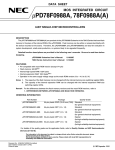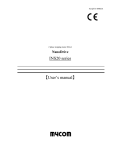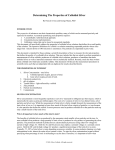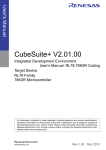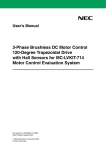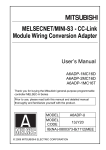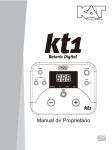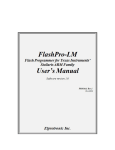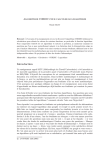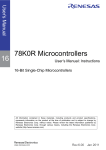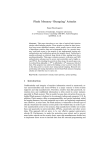Download µPD78F9842
Transcript
DATA PRODUCT
SHEET
PRELIMINARY
INFORMATION
MOS INTEGRATED CIRCUITS
µPD78F9842
8-BIT SINGLE-CHIP MICROCONTROLLER
The µPD78F9842 is a member of µPD789842 Subseries of the 78K/0S Series product.
The µPD78F9842 is a product that has expanded the internal ROM of the µPD789841 and 789842, and replaced
it with flash memory.
Flash memory can be written or erased electrically on board, making the µPD78F9842 best suited for prototypes
in system development, small-scale production, or systems likely to be upgraded frequently.
The details of functions are described in the following user's manuals. Be sure to read them before
designing.
µPD789842 Subseries User's Manual: U13776E
78K/0S Series User's Manual Instructions: U11047E
FEATURES
{ Pin-compatible with mask ROM versions (other than the VPP pin)
{ Flash memory: 16 Kbytes
{ Internal high-speed RAM: 256 bytes
{ Selectable minimum instruction execution time: High speed (0.24 µs) and low speed (0.96 µs) (with the system
clock operating at 8.38 MHz)
{ I/O ports: 30
{ Timer: 6 channels
• 10-bit inverter control timer: 1 channel
• 8-bit timer/event counter: 2 channels
• 8-bit timer counter: 1 channel
• Watch timer: 1 channel
• Watchdog timer: 1 channel
{ A/D converter with 8-bit resolution: 8 channels
{ Serial interface (UART00): 1 channel
{ Multiplier: 10 bits × 10 bits = 20 bits
{ SWAP: contents of the high-order 4 bits and the low-order 4 bits of the 8-bit register are switchable.
{ Vectored interrupt sources: 14
{ Power supply voltage: VDD = 4.0 V to 5.5 V
APPLICATIONS
Inverter air conditioners, etc.
The information contained in this document is being issued in advance of the production cycle for the
device. The parameters for the device may change before final production or NEC Corporation, at its own
discretion, may withdraw the device prior to its production.
Document No. U13901EJ1V0PM00 (1st edition)
Date Published December 1998 N CP(K)
Printed in Japan
©
1998
µPD78F9842
ORDERING INFORMATION
Part number
2
Package
PD78F9842GB-3BS-MTX
44-pin plastic QFP (10 × 10 mm, 2.7 mm resin thickness)
PD78F9842GB-8ES
44-pin plastic QFP (10 × 10 mm, 1.4 mm resin thickness)
Preliminary Product Information
µPD78F9842
78K/0S SERIES DEVELOPMENT
The products of the 78K/0S Series are shown below. The subseries names are indicated in the frames.
In production
Under development
For small-scale, general-purpose applications
With a built-in subsystem clock in the µ PD789026
42/44-pin
µ PD789046
µ PD789026
Device developed by enhancing the timer function of the µ PD789014 and expanding ROM and RAM
28-pin
µ PD789014
With a built-in UART bus and capable of low-voltage (1.8 V) operation
44-pin
For small-scale, general-purpose applications and A/D function
44/48-pin
µ PD789217AY
RC-oscillator version of the µ PD789197AY
44/48-pin
µ PD789197AY
With built-in EEPROMTM and SMB in the µ PD789177
44-pin
44-pin
30-pin
78K0/0S
Series
µ PD789177
µ PD789167
Device developed by enhancing the A/D function of the µ PD789167
µ PD789156
Device developed by enhancing the A/D function of the µ PD789146
Device developed by adding EEPROM to the µ PD789104A
µ PD789146
30-pin
Device developed by enhancing the timers of the µ PD789104A
28/30-pin
µ PD789134A
Device developed by enhancing the A/D function of the µ PD789124A
28/30-pin
RC-oscillator version of the µ PD789104A
28/30-pin
µ PD789124A
µ PD789114A
28/30-pin
µ PD789104A
Device developed by adding an A/D function and multiplier to the µ PD789026
Device developed by enhancing the A/D function of the µ PD789104A
For inverter control
44-pin
µ PD789842
Inverter control circuit, with built-in UART
For LCD driving
80-pin
µ PD789417A
Device developed by enhancing the A/D function of the µ PD789407A
80-pin
µ PD789407A
µ PD789830
Device developed by adding an A/D function and enhancing the timers of the µ PD789026
88-pin
With built-in UART bus and dot LCD
For ASSP
44-pin
µ PD789840
Device for a key-pad, with a built-in POC
5-pin
µ PD789810
Device for an IC card, with a built-in security circuit
42/44-pin
µ PD789800
Device for a PC keyboard, with a built-in USB function
Preliminary Product Information
3
µPD78F9842
The following table lists the major differences in functions between the subseries.
Function
Subseries
ROM
Capacity 8-bit
Timer
16-bit Watch WDT
8-bit
A/D
10-bit
A/D
1ch
–
–
Small-scale,
generalpurpose
applications
µPD789046
16K
µPD789026
4K to 16K
µPD789014
2K to 4K
2ch
–
Small-scale,
generalpurpose
applications
with A/D
function
µPD789217AY
16K to 24K
3ch
1ch
1ch
1ch
1ch
1ch (UART: 1ch) 34 pins
1ch
1ch
–
8ch
2ch
UART: 1ch
31 pins
µPD789197AY
–
RC-oscillator
version, with onchip EEPROM
With on-chip
EEPROM
µPD789177
1ch (UART: 1ch)
8ch
–
–
4ch
4ch
–
–
4ch
µPD789124A
4ch
–
µPD789114A
–
4ch
µPD789104A
4ch
–
4K to 16K
1ch
–
µPD789146
µPD789134A
Remarks
22 pins
SMB: 1ch
µPD789156
2K to 8K
Inverter
control
µPD789842
8K to 16K
3ch
Note
LCD
driving
µPD789417A
12K to 24K
3ch
1ch
1ch
1ch
µPD789407A
µPD789830
24K
1ch
µPD789840
8K
2ch
µPD789810
6K
–
µPD789800
8K
2ch
–
7ch
7ch
–
–
1ch
4ch
With on-chip
EEPROM
RC-oscillator
version
–
1ch (UART: 1ch) 30 pins
–
1ch (UART: 1ch) 43 pins
–
–
–
–
20 pins
30 pins
–
1ch
–
29 pins
–
2ch (USB:1ch)
Note 10-bit timer: 1 channel
4
I/O
–
µPD789167
ASSP
Serial Interface
Preliminary Product Information
1 pin
31 pins
With on-chip
EEPROM
µPD78F9842
FUNCTIONS
Item
Internal memory
Function
Flash memory
16 Kbytes
High-speed RAM
256 bytes
Minimum instruction execution time
0.24 µs/0.96 µs (with system clock operating at 8.38 MHz)
General-purpose register
8 bits × 8 registers
Instruction set
16-bit operations
Bit manipulations (such as set, reset, and test)
I/O ports
Timers
Total
: 30
CMOS input/output pins
: 22
CMOS input pins
:8
10-bit inverter control timer
: 1 channel
8-bit timer/event counter
: 2 channels
8-bit timer counter
: 1 channel
Watch timer
: 1 channel
Watchdog timer
: 1 channel
A/D converters
8-bit resolution × 8 channels
Serial interface
UART: 1 channel
Multiplier
10 bits × 10 bits = 20 bits
SWAP
Contents of the high-order 4 bits and the low-order 4 bits of the 8-bit register are
switchable
Vectored interrupt
sources
Maskable
11 internal and 2 external interrupts
Nonmaskable
One internal interrupt
Power supply voltage
VDD = 4.0 to 5.5 V
Operating ambient temperature
TA = −40 to +85°C
Package
44-pin plastic QFP (10 × 10 mm)
Preliminary Product Information
5
µPD78F9842
CONTENTS
1. PIN CONFIGURATION (TOP VIEW) ..................................................................................................... 7
2. BLOCK DIAGRAM................................................................................................................................. 8
3. PIN FUNCTIONS.................................................................................................................................... 9
3.1
Port Pins..........................................................................................................................................................9
3.2
Non-Port Pins................................................................................................................................................10
3.3
Pin Input/Output Circuits and Connection of Unused Pins ......................................................................11
4. MEMORY SPACE ................................................................................................................................ 13
5. FLASH MEMORY PROGRAMMING .................................................................................................. 14
5.1
Selecting Transmission Method .................................................................................................................14
5.2
Flash Memory Programming Function .......................................................................................................15
5.3
Connecting Flashpro III................................................................................................................................15
5.4
Settings for Flashpro III ...............................................................................................................................16
6.
INSTRUCTION SET OVERVIEW .................................................................................................... 17
6.1
Conventions..................................................................................................................................................17
6.2
Operations.....................................................................................................................................................19
7. ELECTRICAL SPECIFICATIONS........................................................................................................ 24
8. PACKAGE DRAWINGS....................................................................................................................... 33
APPENDIX A
DIFFERENCES BETWEEN THE µPD78F9842 AND MASK ROM VERSIONS....... 35
APPENDIX B
DEVELOPMENT TOOLS ................................................................................................ 36
APPENDIX C
RELATED DOCUMENTS ............................................................................................... 38
6
Preliminary Product Information
µPD78F9842
1. PIN CONFIGURATION (TOP VIEW)
•
44-pin plastic QFP
TO75
RESET
VPP
X2
X1
VSS
VDD
AVDD
P60/ANI0
P61/ANI1
P62/ANI2
µPD78F9842GB-3BS-MTX (10 × 10 mm, 2.7 mm resin thickness)
µPD78F9842GB-8ES (10 × 10 mm, 1.4 mm resin thickness)
TO72
30
TO71
P67/ANI7
5
29
TO70
AVSS
6
28
P25/INTP1/TI81
P00
7
27
P24/INTP0/TI80
P01
8
26
P23/TO82
P02
9
25
P22/RxD
P03
10
24
P21/TxD
P04
11
23
12 13 14 15 16 17 18 19 20 21 22
P20/TOFF7
P17
P16
31
4
P15
3
P66/ANI6
P14
P65/ANI5
P13
TO73
P12
32
P11
2
P10
TO74
P64/ANI4
P07
44 43 42 41 40 39 38 37 36 35 34
33
P06
1
P05
P63/ANI3
Cautions 1. Connect the VPP pin directly to the VSS pin.
2. Connect the AVDD pin to the VDD pin.
3. Connect the AVSS pin to the VSS pin.
ANI0 to ANI7
: Analog Input
RxD
: Receive Data
AVDD
: Analog Power Supply
TI80, TI81
: Timer Input
AVSS
: Analog Ground
TI70 to TO75, TO82 : Timer Output
INTP0, OMTP1
: Interrupt from Peripherals
TOFF7
P00 to P07
: Port0
TxD
: Transmit Data
P10 to P17
: Port1
VDD
: Power Supply
P20 to P25
: Port2
VPP
: Programming Power Supply
P60 to P67
: Port6
VSS
: Ground
RESET
: Reset
X1, X2
: Crystal
: Timer Output Off
Preliminary Product Information
7
µPD78F9842
2. BLOCK DIAGRAM
TI80/P24
/INTP0
TI81/P25
/INTP1
TO82/P23
TO70-TO75
TOFF7/P20
8-bit TIMER/
EVENT COUNTER80
PORT 0
P00-P07
PORT 1
P10-P17
PORT 2
P20-P25
PORT 6
P60-P67
8-bit TIMER/
EVENT COUNTER81
78K/0S
CPU CORE
8-bit TIMER
COUNTER82
FLASH
MEMORY
10-bit INVERTER
CONTROL TIMER
A/D
CONVERTER
ANI0/P60ANI7/P67
AVDD
AVSS
WATCHDOG TIMER
WATCH TIMER
TxD/P21
RxD/P22
INTP0/P24
/TI80
INTP1/P25
/TI81
8
SYSTEM
CONTROL
RAM
MULTIPLIER
UART00
H/L
INTERRUPT
CONTROL
VDD
VSS
SWP
VPP
L/H
Preliminary Product Information
RESET
X1
X2
µPD78F9842
3. PIN FUNCTIONS
3.1
Port Pins
Pin Name
I/O
Function
After Reset
Alternate Function
P00 to P07
I/O
Port 0
8-bit input/output port
Input/output can be specified in 1-bit units
When used as an input port, on-chip pull-up resistor connection can be
specified by means of software.
Input
–
P10 to P17
I/O
Port 1
8-bit input/output port
Input/output can be specified in 1-bit units
When used as an input port, on-chip pull-up resistor connection can be
specified by means of software.
Input
–
P20
I/O
Port 2
6-bit input/output port
Input/output can be specified in 1-bit units
On-chip pull-up resistor connection can be specified by means of
software.
Input
P21
P22
P23
TOFF7
TxD
RxD
TO82
P24
INTP0/TI80
P25
INTP1/TI81
P60 to P67
Input
Port 6
Input
ANI0-ANI7
8-bit input-only port
Preliminary Product Information
9
µPD78F9842
3.2
Non-Port Pins
Pin Name
INTP0
I/O
Input
INTP1
Function
After Reset
External interrupt inputs for which effective edges (rising and/or falling
edges) can be specified
Input
Alternate Function
P24/TI80
P25/TI81
RxD
Input
Serial data input for asynchronous serial interface
Input
P22
TxD
Output
Serial data output for asynchronous serial interface
Input
P21
TO70 to TO75 Output
Timer output from timer for 10-bit inverter control timer
TOFF7
Input
External input to stop timer output (TO70 to TO75)
Input
P20
TI80
Input
External count clock input of TM80
Input
P24/INTP0
TI81
TO82
ANI0 to ANI7
AVSS
External count clock input of TM81
Output
Input
–
AVDD
X1
Input
X2
–
RESET
Output
Input
–
P25/INTP1
Timer output of TM82
Input
P23
A/D converter analog input
Input
P60 to P67
A/D converter ground potential
–
–
A/D converter analog power supply
–
–
Crystal resonator connection for system clock oscillation
–
–
–
–
Input
–
System reset input
VDD
–
Positive power supply for ports
–
–
VSS
–
Ground potential ports
–
–
VPP
–
This pin is used to set the flash memory programming mode and
applies a high voltage when a program is written or verified. In normal
operation mode, connect this pin directly to the VSS pin.
–
–
10
Preliminary Product Information
µPD78F9842
3.3
Pin Input/Output Circuits and Connection of Unused Pins
Table 3-1 lists the input/output circuit-type for each pin and explains how unused pins are handled.
Figure 3-1 shows the configuration of each type of input/output circuit.
Table 3-1. Type of Input/Output Circuit for Each Pin and Connection of Unused Pins
Pin Name
P00 to P07
I/O Circuit Type
I/O
5-A
I/O
P10 to P17
P20/TOFF7
Recommended Connection of Unused Pins
When used as inputs: individually connect these pins to the VDD or VSS pin
via resistors.
When used as outputs: leave these pins open.
8-A
P21/TxD
P22/RxD
P23/TO82
P24/INTP0/TI80
P25/INTP1/TI81
P60/ANI0 to
P67/ANI7
9-C
Input
TO70 to TO75
4
Output
RESET
2
Input
VPP
–
–
Connect these pins directly to the VDD or VSS pin.
Individually connect these pins to the VDD or VSS pin via resistors.
–
Connect this pin directly to the VSS.
Preliminary Product Information
11
µPD78F9842
Figure 3-1. Pin Input/Output Circuits
Type 2
VDD
Type 8-A
Pull-up
enable
P-ch
VDD
IN
Data
P-ch
IN/OUT
Schmitt trigger input with a hysteresis characteristics
Type 4
Output
disable
N-ch
VSS
Type 9-C
VDD
Data
IN
P-ch
+
-
AVSS
IN/OUT
Output
disable
Comparator
P-ch
N-ch
VREF
Threshold voltage
N-ch
VSS
Input
enable
Type 5-A
VDD
Pull-up
enable
P-ch
VDD
Data
P-ch
IN/OUT
Output
disable
N-ch
VSS
Input
enable
12
Preliminary Product Information
µPD78F9842
4. MEMORY SPACE
The µPD78F9842 can access up to 64 Kbytes of memory space. Figure 4-1 shows the memory map.
Figure 4-1. Memory Map
FFFFH
Special function register
256 × 8 bits
FF00H
FEFFH
Internal high-speed RAM
256 × 8 bits
FE00H
FDFFH
Reserved
Data memory
space
3FFFH
4000H
3FFFH
Program area
Program memory
space
Internal flash memory
16384 × 8 bits
0080H
007FH
CALLT table area
0040H
003FH
Program area
001EH
001DH
0000H
0000H
Preliminary Product Information
Vector table area
13
µPD78F9842
5. FLASH MEMORY PROGRAMMING
The internal program memory of the µPD78F9842 is flash memory.
Flash memory can be written to even while the device is mounted in the target system (on-board write). To write a
program to flash memory, connect the dedicated flash programmer (Flashpro III (Model number: FL-PR3 and PGFP3)) to both the host machine and target system.
Remark The FL-PR3 is manufactured by Naito Densei Machidaseisakusho.
5.1
Selecting Transmission Method
The Flashpro III writes to flash memory by means of serial transmission. The transmission method to be used for
writing is selected from those listed in Table 5-1. To select a transmission method, use the format shown in Figure 51, according to the number of VPP pulses listed in Table 5-1.
Table 5-1. Transmission Methods
Transmission Method
UART
Pseudo three-wire mode
Note
Pins
Number of VPP pulses
TxD/P21
RxD/P22
8
P00 (serial clock input)
P01 (serial data output)
P02 (serial data input)
12
Note Serial transfer is performed by controlling the ports using software.
Caution To select a transmission method, always use the corresponding number of VPP pulses listed in
Table 5-1.
Figure 5-1. Format of Transmission Method Selection
10 V
VPP
VDD
1
VSS
VDD
RESET
VSS
14
Preliminary Product Information
2
n
µPD78F9842
5.2
Flash Memory Programming Function
Flash memory writing and other operations can be performed by transmitting/receiving commands and data
according to the selected transmission method. Table 5-2 lists the main flash memory programming functions.
Table 5-2. Main Flash Memory Programming Functions
Function
Description
Batch erase
Erases the entire memory contents.
Batch blank check
Checks that the entire memory contents have been erased.
Data write
Writes to the flash memory according to the specified write start address and number of bytes of
data to be written.
Batch verify
Compares the entire memory contents with the input data.
5.3
Connecting Flashpro III
The connection between the Flashpro III and the µPD78F9842 varies with the transmission method (UART or
pseudo 3-wire). Figures 5-2 and 5-3 show the connection for each transmission method.
Figure 5-2. Flashpro III Connection in UART Mode
µ PD78F9842
Flashpro III
VPPnNote
VDD
RESET
VPP
VDD, AVDD
RESET
SO
RxD
SI
TxD
GND
VSS, AVSS
Note n: 0 or 1
Figure 5-3. Flashpro III Connection in Pseudo 3-Wire Mode
µ PD78F9842
Flashpro III
VPPnNote
VDD
RESET
VPP
VDD, AVDD
RESET
SCK
P00 (serial clock)
SO
P02 (serial input)
SI
GND
P01 (serial output)
VSS, AVSS
Note n: 0 or 1
Preliminary Product Information
15
µPD78F9842
5.4
Settings for Flashpro III
When using the Flashpro III to write to flash memory, set the Flashpro III as listed in Table 5-3.
Table 5-3. Settings for the Flashpro III
Transmission Method
UART
Pseudo 3-wire mode
Number of VPP Pulses
Settings for the Flashpro III
Type
78 K(2)
RAM
128
ROM
Flash
START ADDRESS
0
END ADDRESS
3FFF
COMM PORT
UART ch-0
CPU CLK
On Target Board
On Target Board
4.1943 MHz
UART BPS
9600 bps
Type
78 K(2)
RAM
128
ROM
Flash
START ADDRESS
0
END ADDRESS
3FFF
COMM PORT
Port A
CPU CLK
On Target Board
Note 1
8
Note 2
12
In Flashpro
On Target Board
4.1943 MHz
SIO CLK
1.00 MHz
In Flashpro
4.00 MHz
SIO CLK
1.00 MHz
Notes 1. The number of VPP pulses supplied from the Flashpro III during the initialization of serial transmission.
Pins to be used in transmission depend on this number.
2. Select one of the following: 9,600, 19,200, 38,400, or 76,800 bps.
Remark COMM PORT : Selection of the serial port
16
SIO CLK
: Selection of the serial clock frequency
CPU CLK
: Selection of the input CPU clock source
Preliminary Product Information
µPD78F9842
6. INSTRUCTION SET OVERVIEW
The instruction set for the µPD78F9842 is listed later.
6.1
Conventions
6.1.1 Operand formats and descriptions
The description made in the operand field of each instruction conforms to the operand format for the instructions
listed below (the details conform to assembly specifications). If more than one operand format is listed for an
instruction, one is selected. Uppercase letters, #, !, $, and square parentheses ([ ]) are used to specify keywords,
which must be written exactly as they appear. The meanings of these special characters are as follows:
#
: Immediate data specification
$
!
: Absolute address specification
[ ] : Indirect address specification
: Relative address specification
Immediate data should be described using appropriate values or labels. The specification of values and labels
must be accompanied by #, !, $, or [ ].
Operand registers, expressed as r or rp in the formats, can be described using both functional names (X, A, C,
etc.) and absolute names (R0, R1, R2, and other names listed in Table 6-1).
Table 6-1. Operand Formats and Descriptions
Format
Description
r
X (R0), A (R1), C (R2), B (R3), E (R4), D (R5), L (R6), H (R7)
rp
AX (RP0), BC (RP1), DE (RP2), HL (RP3)
sfr
Special function register symbol
saddr
FE20H-FF1FH Immediate data or label
saddrp
FE20H-FF1FH Immediate data or label (even-addresses only)
addr16
0000H-FFFFH Immediate data or label
(only even-addresses for 16-bit data transfer instructions)
addr5
0040H-007FH Immediate data or label (even-addresses only)
word
16-bit immediate data or label
byte
8-bit immediate data or label
bit
3-bit immediate data or label
Preliminary Product Information
17
µPD78F9842
6.1.2 Descriptions of the operation field
A
: A register; 8-bit accumulator
X
: X register
B
: B register
C
: C register
D
: D register
E
: E register
H
: H register
L
: L register
AX
: AX register pair; 16-bit accumulator
BC
: BC register pair
DE
: DE register pair
HL
: HL register pair
PC
: Program counter
SP
: Stack pointer
PSW
: Program status word
CY
: Carry flag
AC
: Auxiliary carry flag
Z
: Zero flag
IE
: Interrupt request enable flag
NMIS
: Flag to indicate that a nonmaskable interrupt is being processed
( )
: Contents of a memory location indicated by a parenthesized address or register name
XH, XL
: High-order and low-order 8 bits of a 16-bit register
∧
: Logical product (AND)
∨
: Logical sum (OR)
∨
: Exclusive OR
addr16
: 16-bit immediate data or label
jdisp8
: Signed 8-bit data (displacement value)
: Inverted data
6.1.3 Description of the flag operation field
18
(Blank)
: No change
0
: Cleared to 0
1
: Set to 1
×
: Set or cleared according to the result
R
: Restored to the previous value
Preliminary Product Information
µPD78F9842
6.2
Operations
Flag
Mnemonic
Operand
Byte
Clock
Operation
Z
MOV
XCH
r, #byte
3
6
r ← byte
saddr, #byte
3
6
(saddr) ← byte
sfr, #byte
3
6
sfr ← byte
A, r
Note 1
2
4
A←r
r, A
Note 1
2
4
r←A
A, saddr
2
4
A ← (saddr)
saddr, A
2
4
(saddr) ← A
A, sfr
2
4
A ← sfr
sfr, A
2
4
sfr ← A
A, !addr16
3
8
A ← (addr16)
!addr16, A
3
8
(addr16) ← A
PSW, #byte
3
6
PSW ← byte
A, PSW
2
4
A ← PSW
PSW, A
2
4
PSW ← A
A, [DE]
1
6
A ← (DE)
[DE], A
1
6
(DE) ← A
A, [HL]
1
6
A ← (HL)
[HL], A
1
6
(HL) ← A
A, [HL+byte]
2
6
A ← (HL + byte)
[HL+byte], A
2
6
(HL + byte) ← A
A, X
1
4
A↔X
2
6
A↔r
A, saddr
2
6
A ↔ (saddr)
A, sfr
2
6
A ↔ (sfr)
A, [DE]
1
8
A ↔ (DE)
A, [HL]
1
8
A ↔ (HL)
A, [HL+byte]
2
8
A ↔ (HL + byte)
rp, #word
3
6
rp ← word
AX, saddrp
2
6
AX ← (saddrp)
saddrp, AX
A, r
MOVW
XCHW
Note2
2
8
(saddrp) ← AX
AX, rp
Note3
1
4
AX ← rp
rp, AX
Note3
1
4
rp ← AX
AX, rp
Note3
1
8
AX ↔ rp
AC CY
×
×
×
×
×
×
Notes 1. Except when r = A
2. Except when r = A or X
3. Only when rp = BC, DE, or HL
Remark The instruction clock cycle is based on the CPU clock (fCPU), specified in the processor clock controller
register (PCC).
Preliminary Product Information
19
µPD78F9842
Flag
Mnemonic
Operand
Byte
Clock
Operation
Z
ADD
ADDC
SUB
SUBC
AND
Remark
A, #byte
2
4
A, CY ← A + byte
×
×
×
saddr, #byte
3
6
(saddr), CY ← (saddr) + byte
×
×
×
A, r
2
4
A, CY ← A + r
×
×
×
A, saddr
2
4
A, CY ← A + (saddr)
×
×
×
A, !addr16
3
8
A, CY ← A + (addr16)
×
×
×
A, [HL]
1
6
A, CY ← A + (HL)
×
×
×
A, [HL + byte]
2
6
A, CY ← A + (HL + byte)
×
×
×
A, #byte
2
4
A, CY ← A + byte + CY
×
×
×
saddr, #byte
3
6
(saddr), CY ← (saddr) + byte + CY
×
×
×
A, r
2
4
A, CY ← A + r + CY
×
×
×
A, saddr
2
4
A, CY ← A + (saddr) + CY
×
×
×
A, !addr16
3
8
A, CY ← A + (addr16) + CY
×
×
×
A, [HL]
1
6
A, CY ← A + (HL) + CY
×
×
×
A, [HL + byte]
2
6
A, CY ← A + (HL + byte) + CY
×
×
×
A, #byte
2
4
A, CY ← A − byte
×
×
×
saddr, #byte
3
6
(saddr), CY ← (saddr) − byte
×
×
×
A, r
2
4
A, CY ← A − r
×
×
×
A, saddr
2
4
A, CY ← A − (saddr)
×
×
×
A, !addr16
3
8
A, CY ← A − (addr16)
×
×
×
A, [HL]
1
6
A, CY ← A − (HL)
×
×
×
A, [HL + byte]
2
6
A, CY ← A − (HL + byte)
×
×
×
A, #byte
2
4
A, CY ← A − byte – CY
×
×
×
saddr, #byte
3
6
(saddr), CY ← (saddr) − byte − CY
×
×
×
A, r
2
4
A, CY ← A − r − CY
×
×
×
A, saddr
2
4
A, CY ← A − (saddr) − CY
×
×
×
A, !addr16
3
8
A, CY ← A − (addr16) − CY
×
×
×
A, [HL]
1
6
A, CY ← A − (HL) − CY
×
×
×
A, [HL + byte]
2
6
A, CY ← A − (HL + byte) − CY
×
×
×
A, #byte
2
4
A ← A ∧ byte
×
saddr, #byte
3
6
(saddr) ← (saddr) ∧ byte
×
A, r
2
4
A←A∧r
×
A, saddr
2
4
A ← A ∧ (saddr)
×
A, !addr16
3
8
A ← A ∧ (addr16)
×
A, [HL]
1
6
A ← A ∧ (HL)
×
A, [HL + byte]
2
6
A ← A ∧ (HL + byte)
×
The instruction clock is based on the CPU clock (fCPU), specified in the processor clock controller
register (PCC).
20
AC CY
Preliminary Product Information
µPD78F9842
Flag
Mnemonic
Operand
Byte
Clock
Operation
Z
AC CY
A, #byte
2
4
A ← A ∨ byte
×
saddr, #byte
3
6
(saddr) ← (saddr) ∨ byte
×
A, r
2
4
A←A∨r
×
A, saddr
2
4
A ← A ∨ (saddr)
×
A, !addr16
3
8
A ← A ∨ (addr16)
×
A, [HL]
1
6
A ← A ∨ (HL)
×
A, [HL + byte]
2
6
A ← A ∨ (HL + byte)
×
A, #byte
2
4
A ← A ∨ byte
×
saddr, #byte
3
6
(saddr) ← (saddr) ∨ byte
×
A, r
2
4
A←A∨r
×
A, saddr
2
4
A ← A ∨ (saddr)
×
A, !addr16
3
8
A ← A ∨ (addr16)
×
A, [HL]
1
6
A ← A ∨ (HL)
×
A, [HL + byte]
2
6
A ← A ∨ (HL + byte)
×
A, #byte
2
4
A − byte
×
×
×
saddr, #byte
3
6
(saddr) −byte
×
×
×
A, r
2
4
A–r
×
×
×
A, saddr
2
4
A − (saddr)
×
×
×
A, !addr16
3
8
A − (addr16)
×
×
×
A, [HL]
1
6
A − (HL)
×
×
×
A, [HL + byte]
2
6
A − (HL + byte)
×
×
×
ADDW
AX, #word
3
6
AX, CY ← AX + word
×
×
×
SUBW
AX, #word
3
6
AX, CY ← AX − word
×
×
×
CMPW
AX, #word
3
6
AX − word
×
×
×
INC
r
2
4
r←r+1
×
×
saddr
2
4
(saddr) ← (saddr) + 1
×
×
r
2
4
r←r−1
×
×
saddr
2
4
(saddr) ← (saddr) − 1
×
×
INCW
rp
1
4
rp ← rp + 1
DECW
rp
1
4
rp ← rp − 1
ROR
A, 1
1
2
(CY, A7 ← A0, Am-1 ← Am) × 1
×
ROL
A, 1
1
2
(CY, A0 ← A7, Am+1 ← Am) × 1
×
RORC
A, 1
1
2
(CY ← A0, A7 ← CY, Am-1 ← Am) × 1
×
ROLC
A, 1
1
2
(CY ← A7, A0 ← CY, Am+1 ← Am) × 1
×
OR
XOR
CMP
DEC
Remark
The instruction clock is based on the CPU clock (fCPU), specified in the processor clock controller
register (PCC).
Preliminary Product Information
21
µPD78F9842
Flag
Mnemonic
Operand
Byte
Clock
Operation
Z
AC CY
saddr. bit
3
6
(saddr. bit) ← 1
sfr. bit
3
6
sfr. bit ← 1
A. bit
2
4
A. bit ← 1
PSW. bit
3
6
PSW. bit ← 1
[HL]. bit
2
10
(HL). bit ← 1
saddr. bit
3
6
(saddr. bit) ← 0
sfr. bit
3
6
sfr. bit ← 0
A. bit
2
4
A. bit ← 0
PSW. bit
3
6
PSW. bit ← 0
[HL]. bit
2
10
(HL). bit ← 0
SET1
CY
1
2
CY ← 1
1
CLR1
CY
1
2
CY ← 0
0
NOT1
CY
1
2
CY ← CY
×
CALL
!addr16
3
6
(SP − 1) ← (PC + 3)H, (SP − 2) ← (PC + 3)L,
SET1
CLR1
×
×
×
×
×
×
PC ← addr16, SP ← SP − 2
CALLT
[addr5]
1
8
(SP − 1) ← (PC + 1)H, (SP − 2) ← (PC + 1)L,
PCH ← (00000000, addr5 + 1),
PCL ← (00000000, addr5),
SP ← SP − 2
RET
1
6
PCH ← (SP + 1), PCL ← (SP),
SP ← SP + 2
RETI
1
8
PCH ← (SP + 1), PCL ← (SP),
R
R
R
R
R
R
PSW ← (SP + 2), SP ← SP + 3
NMIS ← 0
PUSH
PSW
1
2
(SP − 1) ← PSW, SP ← SP − 1
rp
1
4
(SP − 1) ← rpH, (SP − 2) ← rpL,
SP ← SP − 2
POP
PSW
1
4
PSW ← (SP), SP ← SP + 1
rp
1
6
rpH, ← (SP + 1) ← rpL, ← (SP),
SP ← SP + 2
MOVW
BR
Remark
SP, AX
2
8
SP ← AX
AX, SP
2
6
AX ← SP
!addr16
3
6
PC ← addr16
$addr16
2
6
PC ← PC + 2 jdisp8
AX
1
6
PCH ← A, PCL ← X
The instruction clock is based on the CPU clock (fCPU), specified in the processor clock controller
register (PCC).
22
Preliminary Product Information
µPD78F9842
Flag
Mnemonic
Operand
Byte
Clock
Operation
Z
BC
$addr16
2
6
PC ← PC + 2 + jdisp8 if CY = 1
BNC
$addr16
2
6
PC ← PC + 2 + jdisp8 if CY = 0
BZ
$addr16
2
6
PC ← PC + 2 + jdisp8 if Z = 1
BNZ
$addr16
2
6
PC ← PC + 2 + jdisp8 if Z = 0
BT
saddr. bit, $addr16
4
10
PC ← PC + 4 + jdisp8 if (saddr. bit) = 1
sfr. bit, $addr16
4
10
PC ← PC + 4 + jdisp8 if sfr. bit = 1
A. bit, $addr16
3
8
PC ← PC + 3 + jdisp8 if A. bit = 1
PSW. bit, $addr16
4
10
PC ← PC + 4 + jdisp8 if PSW. bit = 1
saddr. bit, $addr16
4
10
PC ← PC + 4 + jdisp8 if (saddr. bit) = 0
sfr. bit, $addr16
4
10
PC ← PC + 4 + jdisp8 if sfr. bit = 0
A. bit, $addr16
3
8
PC ← PC + 3 + jdisp8 if A. bit = 0
PSW. bit, $addr16
4
10
PC ← PC + 4 + jdisp8 if PSW. bit = 0
B, $addr16
2
6
B ← B − 1, then
BF
DBNZ
AC CY
PC ← PC + 2 + jdisp8 if B ≠ 0
C, $addr16
2
6
C ← C − 1, then
PC ← PC + 2 + jdisp8 if C ≠ 0
saddr, $addr16
3
8
(saddr) ← (saddr) − 1, then
PC ← PC + 3 + jdisp8 if (saddr) ≠ 0
NOP
1
2
No operation
EI
3
6
IE ← 1 (Enable Interrupt)
DI
3
6
IE ← 0 (Disable Interrupt)
HALT
1
2
Set HALT Mode
STOP
1
2
Set STOP Mode
Remark
The instruction clock is based on the CPU clock (fCPU), specified in the processor clock controller
register (PCC).
Preliminary Product Information
23
µPD78F9842
7. ELECTRICAL SPECIFICATIONS
ABSOLUTE MAXIMUM RATINGS (TA = 25°°C)
Parameter
Rated Value
Unit
VDD
−0.3 to +6.5
V
VPP
−0.3 to +11.0
V
Input voltage
VI
−0.3 to VDD + 0.3
V
Output voltage
VO
−0.3 to VDD + 0.3
V
High-level output current
IOH
Each pin
–10
mA
Total for all pins
–30
mA
Each pin
30
mA
Total for all pins
160
mA
Power supply voltage
Low-level output current
Symbol
IOL
Conditions
Operating ambient temperature
TA
−40 to +85
°C
Storage temperature
Tstg
−65 to +150
°C
Caution Product quality may suffer if the absolute maximum rating is exceeded even momentarily for any
parameter. That is, the absolute maximum ratings are rated values at which the product is on the
verge of suffering physical damage, and therefore the product must be used under conditions
that ensure that the absolute maximum ratings are not exceeded.
Remark Unless otherwise specified, the characteristics of alternate-function pins are the same as those of port
pins.
24
Preliminary Product Information
µPD78F9842
CHARACTERISTICS OF THE SYSTEM CLOCK OSCILLATION CIRCUIT (TA = −40 to +85°°C, VDD = 4.0 to 5.5 V)
Resonator
Recommended circuit
Ceramic
resonator
VPP X2
C2
X1
C2
X1
C1
Conditions
Oscillator frequency
Note 1
(fx)
VDD = oscillation
voltage range
Oscillation
Note 2
stabilization time
Time after the VDD
has reached the
minimum value in the
oscillation voltage
range
C1
VPP X2
Crystal oscillator
Parameter
Oscillator frequency
Note 1
(fx)
MIN.
TYP.
MAX.
Unit
8.0
8.38
8.5
MHz
4
ms
8.5
MHz
10
ms
8.0
8.38
Oscillation
Note 2
stabilization time
Notes 1. Only the characteristics of the oscillation circuit are indicated.
See the description of the AC
characteristics for the instruction execution time.
2. Time required for oscillation to stabilize once a reset sequence ends or STOP mode is released. Use a
resonator that will become stable within the oscillation wait time.
Caution When using the system clock oscillation circuit, observe the following conditions for the wiring
of the sections enclosed in dotted lines in the above diagrams so as to avoid the effects of wiring
capacitance, etc.
•
Keep the wiring as short as possible.
•
Do not allow signal wires to cross one another.
•
Keep the wiring away from wires that carry a high, non-stable current.
•
Keep the grounding point of the capacitors at the same level as the VSS.
•
Do not connect the grounding point to a grounding wire that carries a high current.
•
Do not extract a signal from the oscillation circuit.
Preliminary Product Information
25
µPD78F9842
DC CHARACTERISTICS (TA = −40 to +85°°C, VDD = 4.0 to 5.5 V)
Parameter
High-level output current
Low-level output current
High-level input voltage
Symbol
IOH
IOL
Conditions
MIN.
TYP.
MAX.
Unit
Each pin
–1
mA
Total for all pins
–15
mA
Each pin
10
mA
Total for all pins
80
mA
VIH1
P00 to P07, P10 to P17, P60 to P67
0.7VDD
VDD
V
VIH2
RESET, P20 to P25
0.8VDD
VDD
V
VIH3
X1, X2
VDD – 0.1
VDD
V
VIL1
P00 to P07, P10 to P17, P60 to P67
0
0.3VDD
V
VIL2
RESET, P20 to P25
0
0.2VDD
V
VIL3
X1, X2
0
0.1
V
High-level output voltage
VOH
IOH = –1mA
Low-level output voltage
VOL
IOL = 10mA
High-level input leakage current
ILIH1
VIN = VDD
Low-level input voltage
ILIH2
Low-level input leakage current
IILI1
VIN = 0 V
IILI2
VDD – 1.0
V
1.0
V
Pins other than X1 and X2
3
µA
X1, X2
20
µA
Pins other than X1 and X2
–3
µA
X1, X2
–20
µA
High-level output leakage current
ILOH
VOUT = VDD
3
µA
Low-level output leakage current
ILOL
VOUT = 0 V
–3
µA
Software-specified pull-up resistor
R
VIN = 0 V
200
kΩ
IDD1
8.38-MHz crystal oscillation operating
Note 2
mode
Undefined Undefined
mA
IDD2
8.38-MHz crystal oscillation HALT
mode
Undefined Undefined
mA
IDD3
STOP mode
Undefined Undefined
µA
IDD4
8.38-MHz crystal oscillation A/D
operating mode
Undefined Undefined
mA
Power supply current
Note 1
50
100
Notes 1. The power supply current does not include the current flowing through the on-chip pull-up resistor.
2. During high-speed mode operation (when the processor clock control register (PCC) is cleared to 00H.)
Remark Unless otherwise specified, the characteristics of alternate function pins are the same as those of port
pins.
26
Preliminary Product Information
µPD78F9842
AC CHARACTERISTICS
(1) Basic operations (TA = −40 to +85°°C, VDD = 4.0 to 5.5 V)
Parameter
Symbol
Cycle time (minimum instruction
execution time)
TCY
TI input frequency
fTI
TI input high/low level width
fTIH, fTIL
Interrupt input high/low level width
fINTH, fINTL
RESET input low level width
fRSL
Conditions
MIN.
TYP.
MAX.
Unit
When the PCC is set to 00H
0.24
0.25
µs
When the PCC is set to 02H
0.94
1.00
µs
0
4.0
MHz
INTP0, INTP1
0.1
µs
10
µs
10
µs
(2) Serial interface (UART) (TA = −40 to +85°°C, VDD = 4.0 to 5.5 V)
Parameter
Transfer rate
Symbol
Conditions
At fx = 8.38 MHz operation
Preliminary Product Information
MIN.
TYP.
MAX.
Unit
115200
bps
27
µPD78F9842
AC TIMING MEASUREMENT POINTS (except the X1 input)
0.8VDD
0.2VDD
0.8VDD
Measurement points
0.2VDD
CLOCK TIMING
1/fX
tXL
tXH
VIH4 (MIN.)
X1 input
VIL4 (MAX.)
TI TIMING
tTIL
tTIH
TI80, TI81
INTERRUPT INPUT TIMING
tINTL
INTP0, INTP1
RESET INPUT TIMING
tRSL
RESET
28
Preliminary Product Information
tINTH
µPD78F9842
A/D CONVERTER CHARACTERISTICS (TA = −40 to +85°°C, VDD = 4.0 to 5.5 V)
Parameter
Symbol
Conditions
Resolution
MIN.
TYP.
MAX.
Unit
8
8
8
bit
1.5
LSB
Note
Overall error
Conversion time
tCONV
14
Analog input voltage
VIAN
0
µs
VDD
V
Note No quantization error (±1/2 LSB) is included.
DATA MEMORY STOP MODE LOW SUPPLY VOLTAGE DATA-HOLD CHARACTERISTICS (TA = −40 to +85°°C)
Parameter
Symbol
Conditions
MIN.
Data-hold supply voltage
VDDDR
4.0
Release signal set time
tSREL
0
Oscillation stabilization wait
Note 1
time
tWAIT
TYP.
Cleared by an interrupt request
Unit
5.5
V
µs
15
Cleared by RESET
MAX.
2 /fx
ms
Note 2
ms
Notes 1. The oscillation stabilization time is a period in which the operation of the CPU is stopped in order to
avoid unstable operation at the start of oscillation.
12
15
17
2. The typical (TYP) value can be selected from 2 /fx, 2 /fx, or 2 /fx by bits 0 to 2 (OSTS0 to OSTS2) of
the oscillation stabilization time select register.
Remark fx: system clock oscillation frequency
Preliminary Product Information
29
µPD78F9842
DATA HOLD TIMING (STOP mode release by RESET)
Internal reset operation
HALT mode
STOP mode
Operation mode
Data hold mode
VDD
VDDDR
tSREL
Stop instruction execution
RESET
tWAIT
DATA HOLD TIMING (Standby release signal: STOP mode release by interrupt signal)
HALT mode
STOP mode
Operation mode
Data hold mode
VDD
VDDDR
tSREL
Stop instruction execution
Standby release signal
(interrupt request)
tWAIT
30
Preliminary Product Information
µPD78F9842
FLASH MEMORY PROGRAMMING CHARACTERISTICS
(1) Basic characteristics (TA = −20 to +60°°C, VDD = 4.0 to 5.5 V)
Parameter
Symbol
Conditions
MIN.
TYP.
MAX.
Unit
8.0
8.5
MHz
0.2VDD
V
Clock frequency
fX
Power supply voltage
VPPL
During VPP low-level detection
0
VPPH
During VPP high-level detection
0.8VDD
VDD
1.2VDD
V
VPP
During VPP high-voltage detection
9.7
10.0
10.3
V
50
mA
100
mA
500
µs
20
Times
VDD power supply current
IDD
VPP power supply current
IPP
VPP = 10 V
Write time
TWRT
1 byte
Number of rewrite times
CWRT
Erase time
TERASE
50
6
s
(2) AC CHARACTERISTICS (TA = −20 to +60°°C, VDD = 4.0 to 5.5 V)
Flash memory write mode
Parameter
Symbol
Conditions
MIN.
TYP.
MAX.
Unit
VPP set time
tPSRON
VPP high voltage
1.0
µs
VDD ↑→ VPP ↑ set time
tDRPSR
VPP high voltage
1.0
µs
VPP ↑→ RESET ↑ set time
tPSRRF
VPP high voltage
1.0
µs
RESET ↑→ VPP count start time
tRFCF
1.0
µs
Count execution time
tCOUNT
VPP pulse high-level width and lowlevel width
tCH, tCL
VPP pulse rising time and falling
time
tR, tF
2.0
µs
8.0
Undefined
Preliminary Product Information
ms
µs
31
µPD78F9842
FLASH MEMORY WRITE MODE
VDD
tDRPSR
tCH
tR
10 V
VPP
VDD
tRFCF
0V
RESET
32
tPSRON
tF
tCL
tPSRRF
tCOUNT
Preliminary Product Information
µPD78F9842
8. PACKAGE DRAWINGS
44 PIN PLASTIC QFP (10 × 10 mm) PACKAGE DRAWING
A
B
23
22
33
34
detail of lead end
S
C
D
R
Q
12
11
44
1
F
J
G
H
I
P
M
K
M
N
S
ITEM
L
S
MILLIMETERS
13.2±0.2
0.520 +0.008
–0.009
B
10.0±0.2
0.394 +0.008
–0.009
C
10.0±0.2
0.394 +0.008
–0.009
D
13.2±0.2
0.520 +0.008
–0.009
NOTE
1. Controlling dimension
millimeter.
2. Each lead centerline is located within 0.16 mm (0.007 inch) of
its true position (T.P.) at maximum material condition.
Preliminary Product Information
INCHES
A
F
1.0
0.039
G
1.0
0.039
H
0.37 +0.08
–0.07
0.015 +0.003
–0.004
I
0.16
0.007
J
0.8 (T.P.)
0.031 (T.P.)
K
1.6±0.2
0.063±0.008
L
0.8±0.2
0.031 +0.009
–0.008
M
0.17 +0.06
–0.05
0.007 +0.002
–0.003
N
0.10
0.004
P
2.7±0.1
0.106 +0.005
–0.004
Q
0.125±0.075
R
3° +7°
–3°
0.005±0.003
3° +7°
–3°
S
3.0 MAX.
0.119 MAX.
S44GB-80-3BS-1
33
µPD78F9842
44 PIN PLASTIC QFP (10 × 10 mm) PACKAGE DRAWING
A
B
detail of lead end
23
22
33
34
S
P
C
T
D
R
12
11
44
1
L
U
Q
F
J
G
H
I
M
K
M
N
S
S
NOTE
ITEM
Each lead centerline is located within 0.16 mm of
its true position (T.P.) at maximum material condition.
A
10.0±0.2
C
10.0±0.2
D
12.0±0.2
F
1.0
G
1.0
H
0.37 +0.08
−0.07
I
0.2
J
0.8 (T.P.)
K
1.0±0.2
L
0.5
M
0.17 +0.03
−0.06
N
0.10
P
Q
1.4±0.05
0.1±0.05
R
3° +4°
−3°
S
Preliminary Product Information
12.0±0.2
B
U
34
MILLIMETERS
1.6 MAX.
0.6±0.15
S44GB-80-8ES-1
µPD78F9842
APPENDIX A
DIFFERENCES BETWEEN THE µPD78F9842 AND MASK ROM VERSIONS
The µPD78F9842 is produced by replacing the internal ROM of a mask ROM version with flash memory.
Table A-1 lists the differences between the µPD78F9842 and mask ROM versions.
Table A-1. Differences between the µPD78F9842 and Mask ROM Versions
Flash Memory Version
Item
Internal memory
µPD78F9842
ROM
16 Kbytes
High-speed RAM
256 bytes
Mask ROM Version
µPD789841
8 Kbytes
µPD789842
16 Kbytes
IC pin
Not provided
Provided
VPP pin
Provided
Not provided
Electrical specifications
May differ between the flash memory and mask ROM versions
Caution There are differences in the amount of noise tolerance and noise radiation between flash
memory versions and mask ROM versions. When considering changing from a flash memory
product to a mask ROM version during process from experimental manufacturing to mass
production, make sure to sufficiently evaluate the flash memory versions using commercial
samples (CS) (not engineering samples (ES)) of the mask ROM versions.
Preliminary Product Information
35
µPD78F9842
APPENDIX B
DEVELOPMENT TOOLS
The following development tools are available for developing systems that use the µPD78F9842.
LANGUAGE PROCESSING SOFTWARE
RA78K0S
Notes 1, 2, 3
Assembler package common to the 78K/0S Series
CC78K0S
Notes 1, 2, 3
C compiler package common to the 78K/0S Series
DF789842
Device file for the µPD789842 Subseries
Notes 1, 2, 3, 5
FLASH MEMORY WRITE TOOLS
Flashpro III (Model number: FLNote 4
PR3
, PG-FP3)
FA-44GB
Note 4
Dedicated flash programmer for on-chip flash memory
Flash memory write adapter for 44-pin plastic QFP. Connection is required according to the
target product.
Flashpro III controller
A program controlled by a PC is included in the Flashpro III.
TM
Can be operated in Windows 95.
DEBUGGING TOOLS
IE-78K0S-NS
In-circuit emulator
This in-circuit emulator is used to debug hardware or software when application systems
that use the 78K/0S Series are developed. The IE-78K0S-NS supports the integrated
debugger (ID78K0S-NS). The IE-78K0S-NS is used in combination with an interface
adapter for connection to an AC adapter, emulation probe, or host machine.
IE-70000-MC-PS-B
AC adapter
This adapter is used to supply power from a 100- to 240-V AC outlet.
IE-70000-98-IF-C
Interface adapter
This adapter is required when a PC-9800 series computer (other than a notebook type) is
used as the host machine for the IE-78K0S-NS. (C bus supported)
IE-70000-CD-IF-A
Note 5
PC card interface
This PC card and interface cable are required when a PC-9800 series computer is used as
the host machine for the IE-78K0S-NS. (PCMCIA socket supported)
IE-70000-PC-IF-C
Interface adapter
This adapter is required when IBM PC/AT or compatibles are used as the host machine for
the IE-78K0S-NS. (ISA bus supported)
Note 5
IE-70000-PCI-IF
TM
Interface adapter
This adapter is required when a PCI bus embedded computer is used as the host machine
for the IE-78K0S-NS.
IE-789842-NS-EM1
Emulation board
This board is used to emulate the peripheral hardware specific to the device. The IE789842-NS-EM1 is used in combination with the in-circuit emulator.
NP-44GB
Note 4
SM78K0S
Notes 1, 2
ID78K0S-NS
DF789842
Notes 1, 2, 5
Notes 1, 2, 5
This board is used to connect the in-circuit emulator to the target system. The NP-44GB is
for the 44-pin plastic QFP.
System simulator common to all 78K/0S series units
Integrated debugger common to all 78K/0S series units
Device file for the µPD789842 Subseries
REAL-TIME OS
MX78K0S
36
Notes 1, 2
OS for the 78K/0S Series
Preliminary Product Information
µPD78F9842
Notes 1. Based on the PC-9800 series (MS-DOS
TM
+ Windows)
2. Based on IBM PC/AT and compatibles (Japanese/English Windows)
3. Based on the HP9000 series 700
TM
TM
TM
(HP-UX ), SPARCstation , (SunOS
TM
TM
TM
and Solaris ), and NEWS
TM
(NEWS-OS )
4. Product manufactured by Naito Densei Machidaseisakusho. (+81-44-822-3813). Consult an NEC sales
representative regarding purchase.
5. Under development
Remark The RA78K0S, CC78K0S, and SM78K0S can be used in combination with the DF789842.
Preliminary Product Information
37
µPD78F9842
APPENDIX C
RELATED DOCUMENTS
DOCUMENTS RELATED TO DEVICES
Document No.
Document Name
Japanese
English
µPD789841, 789842 Preliminary Product Information
U13790J
U13790E
µPD78F9842 Preliminary Product Information
U13901J
This manual
µPD789842 Subseries User’s Manual
U13776J
To be prepared
78K/0S Series User's Manual Instruction
U11047J
U11047E
DOCUMENTS RELATED TO DEVELOPMENT TOOLS (USER'S MANUALS)
Document No.
Document Name
Japanese
RA78K0S Assembler Package
English
Operation
U11622J
U11622E
Assembly Language
U11599J
U11599E
Structured Assembly
Language
U11623J
U11623E
Operation
U11816J
U11816E
Language
U11817J
U11817E
SM78K0S System Simulator Windows Base
Reference
U11489J
U11489E
SM78K Series System Simulator
External Parts User Open
Interface Specifications
U10092J
U10092E
ID78K0S-NS Integrated Debugger Windows Base
Reference
U12901J
U12901E
IE-78K0S-NS In-circuit Emulator
U13549J
U13549E
IE-789742-NS-EM1 Emulation Board
To be prepared
To be prepared
CC78K0S C Compiler
DOCUMENTS RELATED TO SOFTWARE TO BE INCORPORATED INTO THE PRODUCT (USER'S MANUALS)
Document No.
Document Name
Japanese
OS for 78K/0S Series MX78K0S
Basics
U12938J
English
U12938E
OTHER DOCUMENTS
Document No.
Document Name
Japanese
IC Package Manual (CD-ROM)
–
English
C13388E
Semiconductor Device Mounting Technology Manual
C10535J
C10535E
Quality Grades on NEC Semiconductor Device
C11531J
C11531E
NEC Semiconductor Device Reliability/Quality Control System
C10983J
C10983E
Guide to Prevent Damage for Semiconductor Devices by Electrostatic Discharge (ESD)
C11892J
C11892E
Guide to Quality Assurance for Semiconductor Devices
Microcomputer Product Series Guide
–
U11416J
MEI-1202
–
Caution The related documents listed above are subject to change without notice. Be sure to use the
latest documents when designing application systems.
38
Preliminary Product Information
µPD78F9842
[MEMO]
Preliminary Product Information
39
µPD78F9842
[MEMO]
40
Preliminary Product Information
µPD78F9842
[MEMO]
Preliminary Product Information
41
µPD78F9842
NOTES FOR CMOS DEVICES
1 PRECAUTION AGAINST ESD FOR SEMICONDUCTORS
Note: Strong electric field, when exposed to a MOS device, can cause destruction
of the gate oxide and ultimately degrade the device operation. Steps must
be taken to stop generation of static electricity as much as possible, and
quickly dissipate it once, when it has occurred. Environmental control must
be adequate. When it is dry, humidifier should be used. It is recommended
to avoid using insulators that easily build static electricity. Semiconductor
devices must be stored and transported in an anti-static container, static
shielding bag or conductive material.
All test and measurement tools
including work bench and floor should be grounded. The operator should
be grounded using wrist strap. Semiconductor devices must not be touched
with bare hands. Similar precautions need to be taken for PW boards with
semiconductor devices on it.
2 HANDLING OF UNUSED INPUT PINS FOR CMOS
Note: No connection for CMOS device inputs can be cause of malfunction. If no
connection is provided to the input pins, it is possible that an internal input
level may be generated due to noise, etc., hence causing malfunction. CMOS
device behave differently than Bipolar or NMOS devices. Input levels of
CMOS devices must be fixed high or low by using a pull-up or pull-down
circuitry.
Each unused pin should be connected to V DD or GND with a
resistor, if it is considered to have a possibility of being an output pin. All
handling related to the unused pins must be judged device by device and
related specifications governing the devices.
3 STATUS BEFORE INITIALIZATION OF MOS DEVICES
Note: Power-on does not necessarily define initial status of MOS device. Production process of MOS does not define the initial operation status of the device.
Immediately after the power source is turned ON, the devices with reset
function have not yet been initialized. Hence, power-on does not guarantee
out-pin levels, I/O settings or contents of registers. Device is not initialized
until the reset signal is received. Reset operation must be executed immediately after power-on for devices having reset function.
42
Preliminary Product Information
µPD78F9842
Regional Information
Some information contained in this document may vary from country to country. Before using any NEC
product in your application, pIease contact the NEC office in your country to obtain a list of authorized
representatives and distributors. They will verify:
•
Device availability
•
Ordering information
•
Product release schedule
•
Availability of related technical literature
•
Development environment specifications (for example, specifications for third-party tools and
components, host computers, power plugs, AC supply voltages, and so forth)
•
Network requirements
In addition, trademarks, registered trademarks, export restrictions, and other legal issues may also vary
from country to country.
NEC Electronics Inc. (U.S.)
NEC Electronics (Germany) GmbH
NEC Electronics Hong Kong Ltd.
Santa Clara, California
Tel: 408-588-6000
800-366-9782
Fax: 408-588-6130
800-729-9288
Benelux Office
Eindhoven, The Netherlands
Tel: 040-2445845
Fax: 040-2444580
Hong Kong
Tel: 2886-9318
Fax: 2886-9022/9044
NEC Electronics (France) S.A.
Velizy-Villacoublay, France
Tel: 01-30-67 58 00
Fax: 01-30-67 58 99
Seoul Branch
Seoul, Korea
Tel: 02-528-0303
Fax: 02-528-4411
NEC Electronics (France) S.A.
NEC Electronics Singapore Pte. Ltd.
Milton Keynes, UK
Tel: 01908-691-133
Fax: 01908-670-290
Spain Office
Madrid, Spain
Tel: 01-504-2787
Fax: 01-504-2860
United Square, Singapore 1130
Tel: 65-253-8311
Fax: 65-250-3583
NEC Electronics Italiana s.r.l.
NEC Electronics (Germany) GmbH
Milano, Italy
Tel: 02-66 75 41
Fax: 02-66 75 42 99
Scandinavia Office
Taeby, Sweden
Tel: 08-63 80 820
Fax: 08-63 80 388
NEC Electronics (Germany) GmbH
Duesseldorf, Germany
Tel: 0211-65 03 02
Fax: 0211-65 03 490
NEC Electronics (UK) Ltd.
NEC Electronics Hong Kong Ltd.
NEC Electronics Taiwan Ltd.
Taipei, Taiwan
Tel: 02-2719-2377
Fax: 02-2719-5951
NEC do Brasil S.A.
Electron Devices Division
Rodovia Presidente Dutra, Km 214
07210-902-Guarulhos-SP Brasil
Tel: 55-11-6465-6810
Fax: 55-11-6465-6829
J98. 11
Preliminary Product Information
43
µPD78F9842
EEPROM is a trademark of NEC Corporation.
MS-DOS and Windows are either registered trademarks or trademarks of Microsoft Corporation in the
United States and/or other countries.
PC/AT is a trademark of International Business Machines Corporation.
HP9000 series 700 and HP-UX are trademarks of Hewlett-Packard Company.
SPARCstation is a trademark of SPARC International, Inc.
Solaris and SunOS are trademarks of Sun Microsystems, Inc.
NEWS and NEWS-OS are trademarks of SONY Corporation.
The related documents in this publication may include preliminary versions. However, preliminary
versions are not marked as such.
No part of this document may be copied or reproduced in any form or by any means without the prior written
consent of NEC Corporation. NEC Corporation assumes no responsibility for any errors which may appear in this
document.
NEC Corporation does not assume any liability for infringement of patents, copyrights or other intellectual
property rights of third parties by or arising from use of a device described herein or any other liability arising
from use of such device. No license, either express, implied or otherwise, is granted under any patents,
copyrights or other intellectual property rights of NEC Corporation or others.
While NEC Corporation has been making continuous effort to enhance the reliability of its semiconductor devices,
the possibility of defects cannot be eliminated entirely. To minimize risks of damage or injury to persons or
property arising from a defect in an NEC semiconductor device, customers must incorporate sufficient safety
measures in its design, such as redundancy, fire-containment, and anti-failure features.
NEC devices are classified into the following three quality grades:
"Standard", "Special", and "Specific". The Specific quality grade applies only to devices developed based on
a customer designated "quality assurance program" for a specific application. The recommended applications
of a device depend on its quality grade, as indicated below. Customers must check the quality grade of each
device before using it in a particular application.
Standard: Computers, office equipment, communications equipment, test and measurement equipment,
audio and visual equipment, home electronic appliances, machine tools, personal electronic
equipment and industrial robots
Special: Transportation equipment (automobiles, trains, ships, etc.), traffic control systems, anti-disaster
systems, anti-crime systems, safety equipment and medical equipment (not specifically designed
for life support)
Specific: Aircrafts, aerospace equipment, submersible repeaters, nuclear reactor control systems, life
support systems or medical equipment for life support, etc.
The quality grade of NEC devices is "Standard" unless otherwise specified in NEC's Data Sheets or Data Books.
If customers intend to use NEC devices for applications other than those specified for Standard quality grade,
they should contact an NEC sales representative in advance.
Anti-radioactive design is not implemented in this product.
M4 96. 5












































